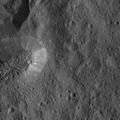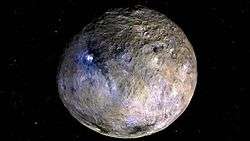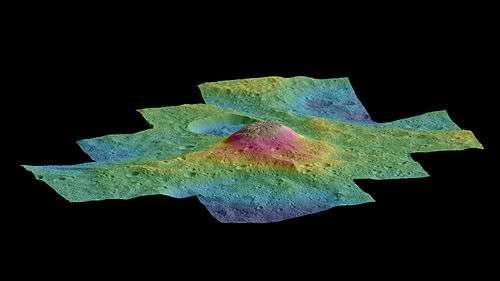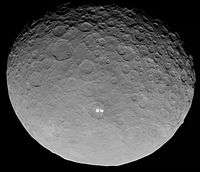Ahuna Mons
|
The mountain imaged by the Dawn spacecraft. North is down. | |
| Location | Ceres |
|---|---|
| Coordinates | 10°28′S 315°48′E / 10.46°S 315.8°ECoordinates: 10°28′S 315°48′E / 10.46°S 315.8°E |
| Peak | about 4 km (2 mi or 13,000 ft) high[1] |
| Discoverer |
Dawn spacecraft team 2015 |
| Eponym | Ahuna, harvest festival of the Sumi Naga from India. |
Ahuna Mons[2] /əˈhuːnə ˈmɒnz/ is the largest mountain on the dwarf planet and asteroid Ceres. It protrudes above otherwise smooth terrain, it is not an impact feature, and it appears to be the only mountain of its kind on Ceres. Bright streaks run top to bottom on its slopes; these streaks are thought to be salt, similar to the better known Cererian bright spots,[3] and likely resulted from cryovolcanic activity from Ceres's interior.[4] It is named after the traditional post-harvest festival Ahuna of the Sumi Naga people of India.
Discovery
The mountain was discovered on images taken by the Dawn spacecraft in orbit around Ceres in 2015.[5] It is estimated to have an average height of about 4 km (2.5 mi; 13,000 ft) and a maximum height of about 5 km (3.1 mi; 16,000 ft) on its steepest side; it is about 20 km (12 mi; 66,000 ft) wide at the base.[1]
Origin
It has been proposed that Ahuna Mons formed as a cryovolcanic dome.[6][7] It is roughly antipodal to the largest impact basin on Ceres, 280 km (170 mi) diameter Kerwan. Seismic energy from the Kerwan-forming impact may have been focused on the opposite side of Ceres, fracturing the outer layers of the area and facilitating the movement of high viscosity cryovolcanic magma (consisting of muddy water ice softened by its content of salts) that was then extruded onto the surface. Crater counts suggest that formation of the mountain continued into the last several hundred million years, making this a relatively young geological feature.[7]
Gallery

Elevation exaggerated by two (1 September 2016).
-

Ceres viewed by Dawn. The north face of Ahuna Mons projects above the center of the limb. North is down.
-

Context view of the mountain surrounded by lightly cratered terrain. Bright spots on Ceres can be seen at 11:00. North is up.
-

Context view of Ahuna Mons (upper left)
(28 September 2015). -

Context view of Ahuna Mons (upper right)
(14 October 2015). -

Close-up view
(20 March 2016). -

Computer-generated image of Ahuna Mons
Elevation exaggerated by five (6 August 2015).
Animations

(simulated; 01:15; 8 June 2015)[8]

(false colors; 01:12; 9 December 2015)

(color; 03:43; 29 January 2016)
See also
| Wikimedia Commons has media related to Photos of Ceres by Dawn. |
References
- 1 2 "PIA20348: Ahuna Mons Seen from LAMO". Jet Propulsion Lab. 7 March 2016. Retrieved 2016-04-14.
- ↑ Gazetteer of Planetary Nomenclature – Ahuna Mons
- ↑ Stone, Maddie (October 1, 2015). "Ceres' Mysterious Bright Spots Aren't Made of Ice After All". Gizmodo. Retrieved 2016-03-25.
- ↑ Burnham, Robert (December 15, 2015). "Deep freeze puts the squeeze on dwarf planet Ceres". Arizona State University. Retrieved 2016-03-25.
- ↑ "NASA spies 3-mile-tall 'pyramid,' more bright spots on Ceres". Cnet. 17 June 2015. Retrieved 2015-06-19.
- ↑ Skibba, R. (2016-09-01). "Giant ice volcano spotted on dwarf planet Ceres". Nature. doi:10.1038/nature.2016.20526.
- 1 2 Ruesch, O.; Platz, T.; Schenk, P.; McFadden, L. A.; Castillo-Rogez, J. C.; Quick, L. C.; Byrne, S.; Preusker, F.; OBrien, D. P.; Schmedemann, N.; Williams, D. A.; Li, J.- Y.; Bland, M. T.; Hiesinger, H.; Kneissl, T.; Neesemann, A.; Schaefer, M.; Pasckert, J. H.; Schmidt, B. E.; Buczkowski, D. L.; Sykes, M. V.; Nathues, A.; Roatsch, T.; Hoffmann, M.; Raymond, C. A.; Russell, C. T. (2016-09-02). "Cryovolcanism on Ceres". Science. 353 (6303): aaf4286–aaf4286. doi:10.1126/science.aaf4286.
- ↑ Landau, Elizabeth; Dyches, Preston (8 June 2015). "Fly Over Ceres in New Video". NASA. Retrieved 9 June 2015.







